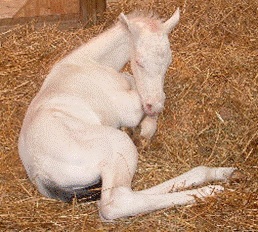
Albino Horses fact or fiction?
Albinism is caused by a recessive gene, which means an animal must have two copies of the gene, one passed down from each parent, in order to express the albino color. In this case it’s actually a lack of color or pigment. If only one copy of the gene is present it has no effect on the coat color and because of this two albino’s bred together will always produce and albino.
With horses the white coat is not caused by a recessive gene and white horses do not breed true as an albino would, so true albinism among horses is non existent. Therefore, with horses there is neither a recessive albino nor a dominant white gene that creates white coats in horses.
White horses come from several different genetic patterns; the crème, grey, sabino, and splash white genes as well as occasionally; extreme overo, tobiano, or tovero patterns. All of these genes act only to modify the horse’s existing coat color and essentially block pigment from otherwise dark hair; they are not really a color in the same sense as bay, black or chestnut.
The grey gene modifies a horses coat and irregardless of what the original coat color is; the grey gene causes it to de-pigment with age. All grey horses are born dark and as they age their coat changes often going through a dappled phase. Some grey horses retain color in their mane, tail, knees and hocks and never entirely turn white and some develop little flecks of color throughout their coats, known as flea-bitten grey. Irregardless, no matter how greyed-out grey horses are, they are genetically grey and never white.
Cremello is another color that is frequently confused as being white or albino. Cremello is the result of two cream genes and once again both parents each pass down one of the Cremello genes, which act on a chestnut base coat. The chestnut coat is diluted to Cremello, by the two cream genes. Cremello is a very pale, golden shade which is often mistaken for white. The Cremellos pale golden pigment and blue eyes often lead to confusion regarding albinos, but true albinism is characterized by red-eyes, pink skin and a total lack of dark pigment.
Several white or nearly white horses are the result of pinto patterns. Pinto, like grey and Cremello, is not really a color, but rather a color modifier. The pinto pattern acts by removing pigment from areas on otherwise solid colored horses. This creates the splashy patterns we see on paints and other horses with large amounts of white. All pinto patterns are dominant and the most common is sabino. Sabino is a pattern of white which can be expressed in as little white as stockings and a blaze, or moderately with belly spots and white patches. However, extreme sabinos can be almost completely covered by the pattern and therefore sometimes appear white.
Splash white is another pinto pattern that can cause completely white horses. It’s similar to sabino because the pattern creeps up the horse starting with the legs and then belly. Splash whites generally have extreme face markings and sometimes even entirely white heads. Splash white in its most extreme form leaves little or no color along the topline and many splash whites are deaf.
